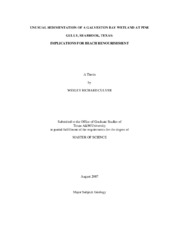| dc.contributor.advisor | Mathewson, Christopher C. | |
| dc.creator | Culver, Wesley Richard | |
| dc.date.accessioned | 2010-01-15T00:14:46Z | |
| dc.date.accessioned | 2010-01-16T02:22:44Z | |
| dc.date.available | 2010-01-15T00:14:46Z | |
| dc.date.available | 2010-01-16T02:22:44Z | |
| dc.date.created | 2007-08 | |
| dc.date.issued | 2009-06-02 | |
| dc.identifier.uri | https://hdl.handle.net/1969.1/ETD-TAMU-1931 | |
| dc.description.abstract | Excess sedimentation began affecting the wetland dynamics of Pine Gully in Seabrook, Texas during the first quarter of 2004. This sedimentation was sudden and became a serious problem for the dynamics of the Pine Gully wetland because the fine, well sorted, quartz rich sediments began plugging the main channel of the previously tidally dominated wetland. Progressive sedimentation has produced overbank deposits in the marine grasses, contributing to the death of wetland grasses by sediment chocking. The main purpose of this study is to determine the new source and mechanism of sedimentation in Pine Gully, document changes from sedimentation, and determine a solution to prevent future sedimentation. Sedimentation in Pine Gully and coastal areas adjacent to Pine Gully has occurred in a region that has experienced subsidence and sea level rise. The sedimentation in Pine Gully is a direct result of new and sustained sediment at the mouth of Pine Gully. These new sediments are transported into Pine Gully by displacement waves from ships moving through the Houston Ship Channel. Beach renourishment at Wright Beach, located a half mile north of Pine Gully, occurred as Pine Gully experienced sedimentation. Construction of a breakwater at the mouth of Pine Gully and subsequent removal of sediment in Pine Gully itself is ultimately the solution to revitalizing the wetland to its pre-sedimentation state. Replanting of native vegetation killed off by sedimentation is recommended and would hasten the recovery of the wetland. Documenting the effects of this unique sedimentation in Pine Gully has implications for the future. Beach renourishment or coastal projects that may contribute excess sediment to the coastline should be concerned with unintended effects they may cause. Although an historically eroding shoreline exists, the effects of excess sedimentation can be severe. A coastal study should be done before sediment is added to the shoreline to identify any areas within the sphere of influence of the project. Ecosystems determined to be within the sphere of influence by a coastal study should implement preventative measures at those locations to avoid an ecological disaster similar to that in Pine Gully. | en |
| dc.format.medium | electronic | en |
| dc.format.mimetype | application/pdf | |
| dc.language.iso | en_US | |
| dc.subject | Sedimentation | en |
| dc.subject | Wetland | en |
| dc.subject | Beach Renourishment | en |
| dc.title | Unusual sedimentation of a Galveston Bay wetland at Pine Gully, Seabrook, Texas: implications for beach renourishment | en |
| dc.type | Book | en |
| dc.type | Thesis | en |
| thesis.degree.department | Geology and Geophysics | en |
| thesis.degree.discipline | Geology | en |
| thesis.degree.grantor | Texas A&M University | en |
| thesis.degree.name | Master of Science | en |
| thesis.degree.level | Masters | en |
| dc.contributor.committeeMember | McInnes, Kevin | |
| dc.contributor.committeeMember | Vitek, Jack | |
| dc.type.genre | Electronic Thesis | en |
| dc.type.material | text | en |
| dc.format.digitalOrigin | born digital | en |


